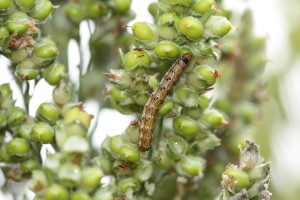
My counterpart in Mississippi, Dr. Catchot , wrote a good article last week on this topic (link here). Headworms are a common problem, especially on later milo. This includes corn earworm, fall armyworm, and sorghum webworms. Typically corn earworm is the most common species present. The treatment threshold for corn earworm or fall armyworm in one or more larva per head. Count sorghum webworms as equivalent to 1/3 of a corn earworm … they are smaller and do less feeding.
Considering the threat of sugarcane aphids, the fact that pyrethroid insecticides will flare this pest, and the sometimes mediocre performance of pyrethroids in controlling headworms, my suggested treatment options are pretty limited. Prevathon (14 oz/acre) or BlackHawk (1.75-2 oz/acre) are the only two insecticides I am recommending on a wide basis. Because it has activity on sorghum midge, BlackHawk is my preferred choice if midge are present, but do not expect the residual control observed with Prevathon. Belt is another option. It is not as consistent as Prevathon at controlling corn earworm in sorghum but is generally pretty good when timed correctly. Besiege is also an option if dealing with midge and headworms. It contains a pyrethroid insecticide so user beware of flaring infestations of sugarcane aphids. I’m not recommending it.
Several folks have asked about reducing the Prevathon rate to 8-10 oz/acre. This is below the lowest labeled rate for headworm control. We’ve just rated plots treated with Prevathon at 6, 10 and 14 oz/acre. At six days after application, control with Prevathon was good at all rates (as was Belt at 2 oz and BlackHawk at 1.7 and 2.5 oz). I suspect Prevathon at 10 oz/acre would give consistent control of headworms, but this is NOT a recommendation unless you want to try it on a limited basis. Unless DuPont has told you different, you’re on your own if you experience a control failure.

